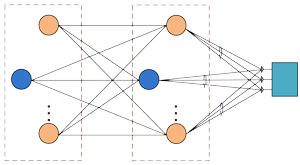Low density parity check code in cooperative MIMO communication at wireless sensor network
DOI:
https://doi.org/10.3103/S073527271107003XKeywords:
cooperative technique, wireless sensor networkAbstract
Energy efficient data transmission is one of the key factors for energy constrained wireless sensor network. Cooperative communication explores the energy efficient wireless communication schemes between multiple sensors and data gathering node. In this paper, an energy efficient cooperative multiple input multiple output technique, which uses low density parity check codes, is suggested. The result shows that the suggested cooperative communication technique outperforms single input single output transmission with error correction code. Bit error rate analysis is also performed.
References
- H. Anna, Wireless Sensor Network Design (Wiley, New York, 2003).
- I. Akyildiz, W. Su, Y. Sankarasubramaniam, and E. Cayirci, “Wireless sensor networks: a survey,” Comput. Netw. 38(2), 393 (2002).
- H. Karvonen, and C. Pomalaza-Raez, “Coding for energy efficient multihop wireless sensor networks,” in Proc. of Nordic Radio Symposium 2004/Finnish Wireless Communications Workshop 2004 (NRS/ FWCW 2004), August 16–18, 2004, Oulu, Finland (Oulu, 2004), pp. 1–5.
- Z. H. Kashani and M. Shiva, “BCH coding and multi-hop communication in wireless sensor networks,” in Proc. Wireless and Optical Networks Conf. (WOCN 2006), April 11–13, 2006, Bangalore, India (Bangalore, 2006), pp. 1–5.
- Y. Sankarasubramaniam, I. F. Akyildiz, and S. W. McLaughlin, “Energy efficiency-based packet size optimization in wireless sensor networks,” in Proc. 1st IEEE Int. Workshop on Sensor Networks Protocols and Applications (SNPA03), May 11, 2003, Anchorage, Alaska, USA (Anchrage, 2003).
- S. Vasudevan, D. Goeckel, and D. Towsley, “Optimal power allocation in channel-coded wireless networks,” in Proc. Annual Allerton Conf. Communication, Control and Computing, October 29–September 1, 2004, Urbana Champaign, USA (Urbana, 2004).
- T. Richardson and R. Urbanke, “Efficient encoding of low-density parity-check codes,” IEEE Trans. Inf. Theory, 47, 638 (2001).
- M. Sartipi and F. Fekri, “Source and channel coding in wireless sensor networks using LDPC codes,” in Proc. IEEE Communications Society Conf. Sensor and Ad Hoc Communications and Networks, October 47, 2004, Santa Clara, CA, USA (Santa Clara, 2004), pp. 309–316.
- A. D. Liveris, C.-F. Lan, K. R. Narayanan, Z. Xiong, and C. N. Georghiades, “Slepian-Wolf coding of three binary sources using LDPC codes,” in Proc. 3rd Int. Symp. on Turbo Codes, Brest, France (Brest, 2003), pp. 63–66.
- S. Cui, A. J. Goldsmith, and A. Bahai, “Energy-efficiency of MIMO and cooperative MIMO techniques in sensor networks,” IEEE J. Sel. Areas Commun. 22, No. 6, 1089 (Aug. 2003).
- S. K. Jayaweera, “Virtual MIMO-based Cooperative Communication for Energyconstrained Wireless Sensor Networks,” IEEE Trans. Wireless Commun. 5, No. 5, 984 (May, 2006).
- X. Li, “Energy efficient wireless sensor networks with transmission diversity,” Electron. Lett. 39, No. 24, 1753 (2003).
- M. R. Islam, H. T. Anh, and J. Kim,“Energy efficient Cooperative Technique for IEEE 1451 based Wireless Sensor Network,” in Proc. of IEEE Wireless Communications and Networking Conference (WCNC), March 2008, USA (2008).
- Y. Gai, L. Zhang, and X. Shan, “Energy Efficiency of cooperative MIMO with data aggregation in wireless sensor networks,” in Proc. of IEEE Wireless Communications&Networking Conference (WCNC), March, 2007, Hong Kong (2007).
- T. K. Tan, A. Raghunathan, G. Lakshminarayana, and N. K. Jha, “High-level Software Energy Macro-Modeling,” in Proc. Design Automation Conf. (June 2001), pp. 605–610.
- M. Luby, M. Mitzenmacher, A. Shokrollahi, and D. Spielman, “Analysis of low density codes and improved designs using irregular graphs,” in Proc. 30th Annu. ACM Symp. Theory of Computing (1998), pp. 249–258.
- M. Luby, M. Mitzenmacher, A. Shokrollahi, and D. Spielman, “Improved low-density parity-check codes using irregular graphs,” IEEE Trans. Inf. Theory 47, No. 2, 585 (Feb. 2001).
- T. Richardson and R. Urbanke, “The capacity of low-density parity-check codes under message-passing decoding,” IEEE Trans. Inf. Theory 47, No. 2, 599 (Feb. 2001).
- T. S. Rappaport, Wireless Communications Principles and Practices, 2nd ed. (Prentice-Hall, New Jersey, 2002).
- R. W. Hamming,“Error detecting and error correcting codes,” Bell Sys. Tech. J. 29, No. 2, 147 (1950).
- I. S. Reed and G. Solomon,“Polynomial codes over certain finite fields,” SIAM J. Appl. Math. 8, 300 (1960).
- R. C. Bose and D. K. Ray-Chaudhuri,“On a class of error correcting binary group codes,” Inform. Control 3, 68 (1960).

Downloads
Published
2011-07-01
Issue
Section
Research Articles

